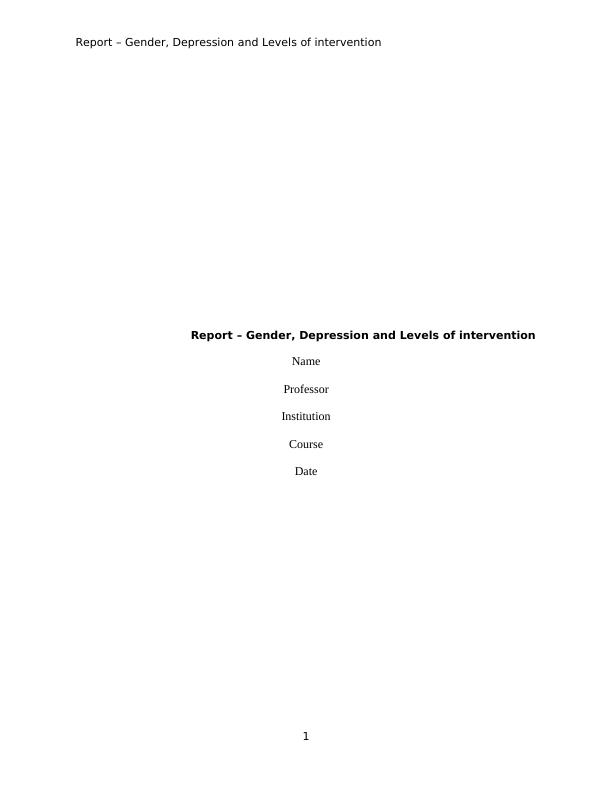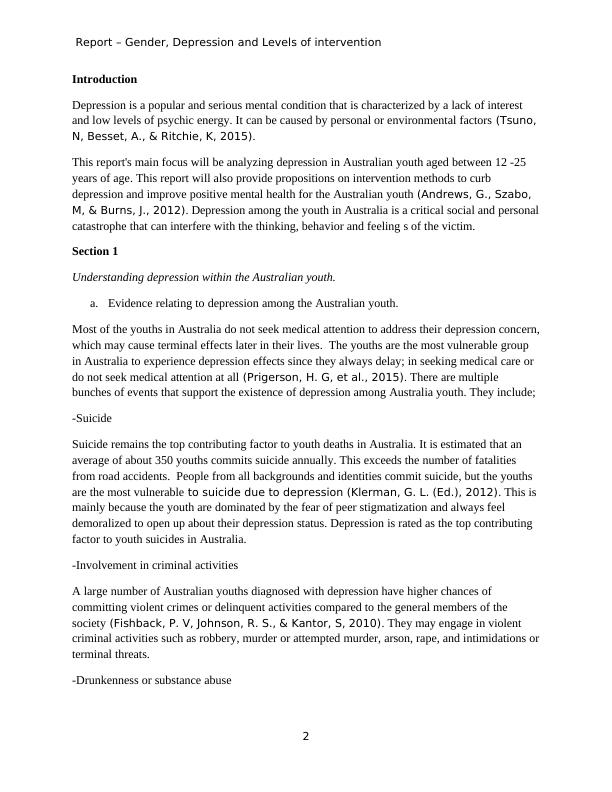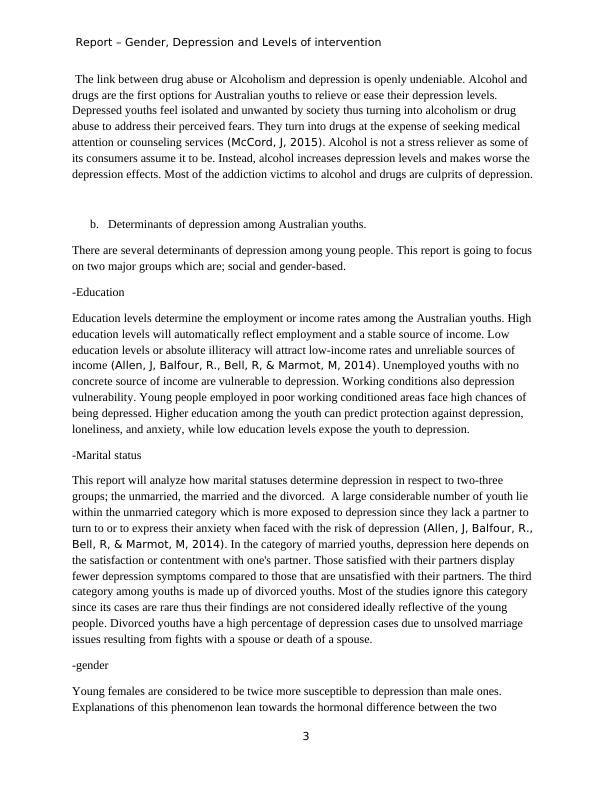Gender, Depression and Levels of intervention – Gender, Depression and Levels of intervention | Report
Analyse the impact of social, environmental and behavioural factors on the health of different populations and develop effective health promotion interventions for gender differences in depression.
7 Pages2103 Words18 Views
Added on 2022-09-15
Gender, Depression and Levels of intervention – Gender, Depression and Levels of intervention | Report
Analyse the impact of social, environmental and behavioural factors on the health of different populations and develop effective health promotion interventions for gender differences in depression.
Added on 2022-09-15
ShareRelated Documents
Report – Gender, Depression and Levels of intervention
Report – Gender, Depression and Levels of intervention
Name
Professor
Institution
Course
Date
1
Report – Gender, Depression and Levels of intervention
Name
Professor
Institution
Course
Date
1

Report – Gender, Depression and Levels of intervention
Introduction
Depression is a popular and serious mental condition that is characterized by a lack of interest
and low levels of psychic energy. It can be caused by personal or environmental factors (Tsuno,
N, Besset, A., & Ritchie, K, 2015).
This report's main focus will be analyzing depression in Australian youth aged between 12 -25
years of age. This report will also provide propositions on intervention methods to curb
depression and improve positive mental health for the Australian youth (Andrews, G., Szabo,
M, & Burns, J., 2012). Depression among the youth in Australia is a critical social and personal
catastrophe that can interfere with the thinking, behavior and feeling s of the victim.
Section 1
Understanding depression within the Australian youth.
a. Evidence relating to depression among the Australian youth.
Most of the youths in Australia do not seek medical attention to address their depression concern,
which may cause terminal effects later in their lives. The youths are the most vulnerable group
in Australia to experience depression effects since they always delay; in seeking medical care or
do not seek medical attention at all (Prigerson, H. G, et al., 2015). There are multiple
bunches of events that support the existence of depression among Australia youth. They include;
-Suicide
Suicide remains the top contributing factor to youth deaths in Australia. It is estimated that an
average of about 350 youths commits suicide annually. This exceeds the number of fatalities
from road accidents. People from all backgrounds and identities commit suicide, but the youths
are the most vulnerable to suicide due to depression (Klerman, G. L. (Ed.), 2012). This is
mainly because the youth are dominated by the fear of peer stigmatization and always feel
demoralized to open up about their depression status. Depression is rated as the top contributing
factor to youth suicides in Australia.
-Involvement in criminal activities
A large number of Australian youths diagnosed with depression have higher chances of
committing violent crimes or delinquent activities compared to the general members of the
society (Fishback, P. V, Johnson, R. S., & Kantor, S, 2010). They may engage in violent
criminal activities such as robbery, murder or attempted murder, arson, rape, and intimidations or
terminal threats.
-Drunkenness or substance abuse
2
Introduction
Depression is a popular and serious mental condition that is characterized by a lack of interest
and low levels of psychic energy. It can be caused by personal or environmental factors (Tsuno,
N, Besset, A., & Ritchie, K, 2015).
This report's main focus will be analyzing depression in Australian youth aged between 12 -25
years of age. This report will also provide propositions on intervention methods to curb
depression and improve positive mental health for the Australian youth (Andrews, G., Szabo,
M, & Burns, J., 2012). Depression among the youth in Australia is a critical social and personal
catastrophe that can interfere with the thinking, behavior and feeling s of the victim.
Section 1
Understanding depression within the Australian youth.
a. Evidence relating to depression among the Australian youth.
Most of the youths in Australia do not seek medical attention to address their depression concern,
which may cause terminal effects later in their lives. The youths are the most vulnerable group
in Australia to experience depression effects since they always delay; in seeking medical care or
do not seek medical attention at all (Prigerson, H. G, et al., 2015). There are multiple
bunches of events that support the existence of depression among Australia youth. They include;
-Suicide
Suicide remains the top contributing factor to youth deaths in Australia. It is estimated that an
average of about 350 youths commits suicide annually. This exceeds the number of fatalities
from road accidents. People from all backgrounds and identities commit suicide, but the youths
are the most vulnerable to suicide due to depression (Klerman, G. L. (Ed.), 2012). This is
mainly because the youth are dominated by the fear of peer stigmatization and always feel
demoralized to open up about their depression status. Depression is rated as the top contributing
factor to youth suicides in Australia.
-Involvement in criminal activities
A large number of Australian youths diagnosed with depression have higher chances of
committing violent crimes or delinquent activities compared to the general members of the
society (Fishback, P. V, Johnson, R. S., & Kantor, S, 2010). They may engage in violent
criminal activities such as robbery, murder or attempted murder, arson, rape, and intimidations or
terminal threats.
-Drunkenness or substance abuse
2

Report – Gender, Depression and Levels of intervention
The link between drug abuse or Alcoholism and depression is openly undeniable. Alcohol and
drugs are the first options for Australian youths to relieve or ease their depression levels.
Depressed youths feel isolated and unwanted by society thus turning into alcoholism or drug
abuse to address their perceived fears. They turn into drugs at the expense of seeking medical
attention or counseling services (McCord, J, 2015). Alcohol is not a stress reliever as some of
its consumers assume it to be. Instead, alcohol increases depression levels and makes worse the
depression effects. Most of the addiction victims to alcohol and drugs are culprits of depression.
b. Determinants of depression among Australian youths.
There are several determinants of depression among young people. This report is going to focus
on two major groups which are; social and gender-based.
-Education
Education levels determine the employment or income rates among the Australian youths. High
education levels will automatically reflect employment and a stable source of income. Low
education levels or absolute illiteracy will attract low-income rates and unreliable sources of
income (Allen, J, Balfour, R., Bell, R, & Marmot, M, 2014). Unemployed youths with no
concrete source of income are vulnerable to depression. Working conditions also depression
vulnerability. Young people employed in poor working conditioned areas face high chances of
being depressed. Higher education among the youth can predict protection against depression,
loneliness, and anxiety, while low education levels expose the youth to depression.
-Marital status
This report will analyze how marital statuses determine depression in respect to two-three
groups; the unmarried, the married and the divorced. A large considerable number of youth lie
within the unmarried category which is more exposed to depression since they lack a partner to
turn to or to express their anxiety when faced with the risk of depression (Allen, J, Balfour, R.,
Bell, R, & Marmot, M, 2014). In the category of married youths, depression here depends on
the satisfaction or contentment with one's partner. Those satisfied with their partners display
fewer depression symptoms compared to those that are unsatisfied with their partners. The third
category among youths is made up of divorced youths. Most of the studies ignore this category
since its cases are rare thus their findings are not considered ideally reflective of the young
people. Divorced youths have a high percentage of depression cases due to unsolved marriage
issues resulting from fights with a spouse or death of a spouse.
-gender
Young females are considered to be twice more susceptible to depression than male ones.
Explanations of this phenomenon lean towards the hormonal difference between the two
3
The link between drug abuse or Alcoholism and depression is openly undeniable. Alcohol and
drugs are the first options for Australian youths to relieve or ease their depression levels.
Depressed youths feel isolated and unwanted by society thus turning into alcoholism or drug
abuse to address their perceived fears. They turn into drugs at the expense of seeking medical
attention or counseling services (McCord, J, 2015). Alcohol is not a stress reliever as some of
its consumers assume it to be. Instead, alcohol increases depression levels and makes worse the
depression effects. Most of the addiction victims to alcohol and drugs are culprits of depression.
b. Determinants of depression among Australian youths.
There are several determinants of depression among young people. This report is going to focus
on two major groups which are; social and gender-based.
-Education
Education levels determine the employment or income rates among the Australian youths. High
education levels will automatically reflect employment and a stable source of income. Low
education levels or absolute illiteracy will attract low-income rates and unreliable sources of
income (Allen, J, Balfour, R., Bell, R, & Marmot, M, 2014). Unemployed youths with no
concrete source of income are vulnerable to depression. Working conditions also depression
vulnerability. Young people employed in poor working conditioned areas face high chances of
being depressed. Higher education among the youth can predict protection against depression,
loneliness, and anxiety, while low education levels expose the youth to depression.
-Marital status
This report will analyze how marital statuses determine depression in respect to two-three
groups; the unmarried, the married and the divorced. A large considerable number of youth lie
within the unmarried category which is more exposed to depression since they lack a partner to
turn to or to express their anxiety when faced with the risk of depression (Allen, J, Balfour, R.,
Bell, R, & Marmot, M, 2014). In the category of married youths, depression here depends on
the satisfaction or contentment with one's partner. Those satisfied with their partners display
fewer depression symptoms compared to those that are unsatisfied with their partners. The third
category among youths is made up of divorced youths. Most of the studies ignore this category
since its cases are rare thus their findings are not considered ideally reflective of the young
people. Divorced youths have a high percentage of depression cases due to unsolved marriage
issues resulting from fights with a spouse or death of a spouse.
-gender
Young females are considered to be twice more susceptible to depression than male ones.
Explanations of this phenomenon lean towards the hormonal difference between the two
3

End of preview
Want to access all the pages? Upload your documents or become a member.
Related Documents
Self Harm: Rationale and Interventionslg...
|12
|987
|328
